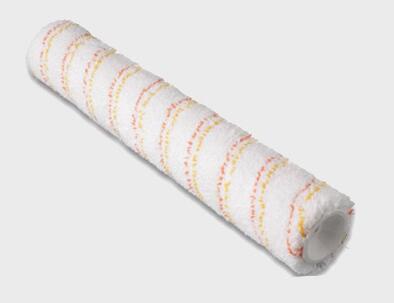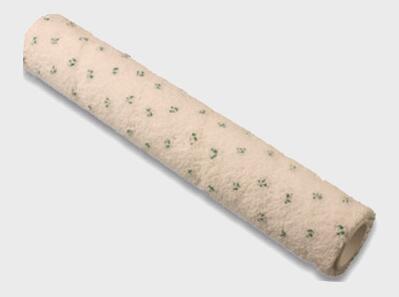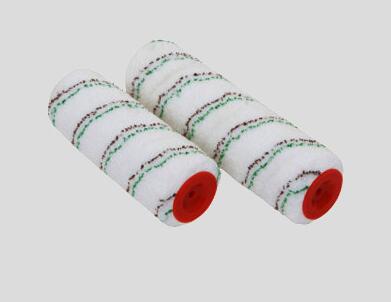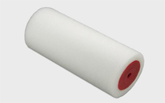When to Use Microfiber Paint Rollers and When Not to Use Them
Apr. 17, 2025Microfiber rollers are becoming increasingly popular for interior home painting and other applications, but they are only effective in certain situations. These rollers can be a boon, but they can also spell trouble if used improperly or for the wrong job.
So when should you use microfiber rollers and when should you not use them? Microfiber rollers should be used for paint projects that require a smooth, consistent application of paint, and not for paint jobs that require paint texture (such as brush strokes).
Microfiber rollers are a great tool to have in any painter's must-have kit, but it's important to know when to use them and, more importantly, how they should be used to get the best results. Read on to learn more about microfiber rollers and how to use them to best complete your project.
What is a microfiber roller?
A microfiber roller is like a traditional woven paint roller, but with a layer of microfiber cloth. The microfiber cloth is just like regular cloth, but the fibers on the microfiber cloth are extremely fine.
On microfiber rollers, the microfiber adheres to the rollers by heating, which makes the microfiber rollers very durable. They do not lose fibers in paint jobs, which can lead to unsightly blemishes in the paint if these fibers get stuck in the paint, which can happen with other rollers.
By definition, microfibers are smaller than silk threads, which themselves are only one-fifth the diameter of a human hair. Microfibers are made from synthetic materials, such as the following (or composites of several of them).
▴ polypropylene
▴ Polyester
▴ nylon
▴ Kevlar
▴Normex
▴ Quigram
▴ Polyamide
Microfibers are very good at absorbing liquids, especially oil-based liquids, and are not hard enough to scratch paint unless they are contaminated with grit or hard debris particles from previous use.
This means that when they are used for painting, they leave an extremely smooth surface with minimal texture, resulting in a smooth, glossy finish in paint projects.
Microfiber rollers are the choice of professionals
Microfiber paint rollers are popular among professional painting contractors because they are lint-free and can apply up to 50% more per roller load.
This means less labor is required to complete each job, and paint jobs can be completed faster because painters don't have to waste time going up and down ladders to load paint onto the roller.
The benefits of microfiber rollers
Microfiber rollers offer many advantages over other types of rollers or the use of paint brushes. The following are some of the advantages of using microfiber rollers instead of other paint rollers or brushes.
1. Microfiber rollers are economical. Most microfiber rollers sell for less than five dollars.
2. Microfiber rollers can be used over and over again. Because they are easy to clean, microfiber rollers can last a long time as long as they are used on a smooth, clean surface (no grit or debris) and cleaned thoroughly after each paint job.
3. Microfiber rollers will absorb large amounts of paint. Microfiber rollers can hold twice their own volume of paint, and can hold more paint than a regular woven paint roller or brush. This means less reloading of the roller up and down.
4. Microfiber rollers can apply paint smoothly. It is difficult to find a paint applicator that provides as fine and smooth a finish as microfiber. For areas that need a glossy finish, microfiber is the best choice. Many areas of the home require a paint finish that is so smooth that there are no visible textures or marks. These are the interior paint jobs that microfiber rollers excel at.
5. Microfiber rollers hold the paint in place, which helps painters avoid splatter. When using woven paint rollers, the paint usually starts to spread the fibers on the paint roller, which allows excess paint to roll off them and spill onto the floor or other areas.
6. Microfiber rollers do not shed lint and do not deposit debris in the paint. Unlike some other rollers and brushes, microfiber rollers do not unload lint as they begin to degrade, which means you don't end up with debris-related blemishes in the paint. This requires the microfiber roller to be kept clean between uses, but the roller will not shed lint like a woven paint roller, nor will it shed lint like a brush. You can achieve a perfectly smooth paint finish every time you use the right application.
What projects are microfiber rollers suitable for?
Microfiber rollers are best used for any paint project that requires a smooth finish because they leave the least amount of texture as you apply them.
Especially in projects where you want to maintain maximum reflectivity, such as those using high-gloss paint, microfiber rollers are a good choice because they do not create texture on the wall surface, which creates micro-shadows and makes the paint job look more boring.
Microfiber rollers are also a good choice for any large paint project because they can hold up to four times the amount of paint they can hold. This means that each paint load on the roller will go farther and you can spray large spaces faster.
Microfiber paint rollers are a good choice in areas where you want to pay special attention to your surroundings because they don't splash. This helps you avoid getting tiny bits of paint on anything in the room you are painting.
What kind of paint should I use on my microfiber roller?
Microfiber rollers can be used with a variety of different paints used inside the home. The following are the types of paints that can be used with a microfiber roller.
△Metallic paint
△Flat/matte lacquer
△Glossy lacquer
△Semi-gloss paint
△Egg shell lacquer
△Satin finish
The smaller the lint on a microfiber roll, the more coverage it will provide. Lint on rolls typically ranges from 1/4" lint to 1" lint and is usually more common in woven rolls than microfiber rolls.
Because they are designed for smooth finish work, microfiber rollers are more often found in smaller naps to add smoothness to the final paint job.
Thicker naps, such as 3/4 inch naps, are more suitable for stucco, brick and masonry work. 3/8 inch naps are most commonly used on ceilings and drywall, while smaller naps are more suitable for walls, wood and metal surfaces.
When not to use microfiber rollers
Since microfiber rollers are best suited for smooth finish work, their capabilities are somewhat wasted on rougher textured surfaces such as brick, stucco and masonry.
Not only do these surfaces not require a fine finish, but the rough texture of these surfaces can damage the microfiber rollers and cause them to wear out more quickly. For these textured surfaces, other types of rollers may be more suitable.
Microfiber rollers are also not suitable for jobs where you want to actually see brush strokes on the wall during the painting job. In some types of interior painting jobs, the texture of the brush strokes is actually ideal for creating an older look.
The best time to paint with a microfiber roller
The main considerations when deciding when to paint your house with a microfiber roller are humidity, temperature and direct sunlight.
If you haven't started painting yet, then you should absolutely consider these factors before starting your project. In some cases, your painting job will go much smoother if you postpone it until the optimal time when the temperature is high and the humidity is low.
Humidity
In general, you should avoid painting when the humidity is high because the paint will be exposed to high levels of water vapor. This can interfere with its ability to bond effectively with the surface and can also cause problems with longer drying times.
For best results, microfiber roll-on paints should be applied at the following humidity conditions.
◭Humidity should be as close to 40% as possible - the higher the humidity above this point, the more difficult the job will be.
◭Paint should not be applied hastily during periods of high humidity. If painting indoors during humid or wet periods, the painter must ensure that each coat is completely dry before starting the next coat. Because paint takes longer to dry in humid conditions, this may even mean waiting overnight between coats.
◭If you are painting outdoors, make sure there is no rain in the forecast. A sudden downpour can ruin all your hard work and cause diluted paint to spill onto other nearby surfaces.
◭In addition to direct exposure of the paint to moisture, moisture on the surface to be painted can cause serious problems with clean paint application. Optimal humidity levels for outdoor painting are usually in the early summer and early fall, so if you have the option to do your painting project at these times of the year, you should do so. Otherwise, you should wait for a humid day when temperatures are low and no rain is expected for the next few days. For indoor painting, winter is a good time of year to paint because the humidity also tends to be lower during this season.
Winter may be a good choice for painting projects because spring and summer are usually busy times of the year when people are exhausted from other obligations of other large projects.
Temperature
Temperatures for painting projects need to be relatively high in order for the paint to adhere properly. The painting temperature should not be below fifty degrees and above sixty degrees is best for painting.
For most interior projects, such as home walls and ceilings, temperature is less important as most homes are equipped with air conditioning and heaters that are always kept at about seventy to eighty degrees. These are the perfect temperature conditions for painting.
However, if you are painting outdoors, you should not be painting at lower temperatures. One thing to consider when painting indoors is that even if the room is warm, the walls, especially those adjacent to the outdoors, may be cooler.
To test the temperature of a surface, you can use a thermometer gun. If you do not have a suitable thermometer, try applying the test area in an inconspicuous area to see how the paint adheres and how it looks after it dries.
Setting up paint rolling with a microfiber roller
Be sure to collect all materials ahead of time before starting a project using a microfiber roller. One of the main causes of accidentally kicking over paint buckets and other painting accidents is caused by having to trek back and forth through the painting area.
Before beginning a painting project with a microfiber roller, the following steps should be observed.
1. Clean the entire painted surface of dust and debris. For walls, a good idea is to wash the walls ahead of time to ensure that there is no dust or other debris on the surface, and then wait for the walls to dry completely before starting to paint.
2. Make sure the floor is protected. The importance of this point cannot be overemphasized. Everyone thinks they are being careful until they spill a whole gallon of interior paint on an unprotected floor. Be sure to cover the entire floor with plastic painters cloth and secure it in the corners with painters tape. If you are painting a ceiling, lay plastic sheeting on each wall and cover them to prevent spills and splatters. While most paint can be removed from hard surfaces while still wet, it can be a pain to do so. If you have carpets, make sure you don't get paint on them, which is especially important because they are absorbent and can cause permanent stains.
3. Remove any pets and protect the aquarium. Paint is highly toxic to ornamental fish, so if you are painting in a room with an aquarium, make sure the aquarium is completely covered with plastic sheeting, or if it is small enough, move it completely. Birds are easily affected by the fumes produced while painting, so they should be removed from the area. Dogs and cats should also be kept out, not because it is unsafe for them, but because they are notorious for knocking over paint trays or walking through them.
How to clean a microfiber roller
One of the biggest benefits of microfiber rollers is that they are easy to clean. If you first lather a microfiber roller with a small dish or hand sanitizer and then spin it out under a running hose until the water runs clear, the microfiber should almost completely remove the excess paint.
Cleaning the microfiber roller
It is important not to allow the paint to soak into the microfiber drum as once the paint starts to solidify, this will cause the microfiber to clump and the drum will no longer be able to produce a smooth surface finish.
An important point to remember is that even if the microfiber roller looks clean, there may still be excess paint inside. Always rinse thoroughly (minimum of 3 times recommended) and soak them in water for a period of time before wringing them out to ensure that all paint is removed.
Don't forget that you should remove the roller cover from the paint roller before rinsing or submerging it in water. This helps prevent the metal parts of the roller from rusting.
Using a Roller Cleaner
There are paint roller cleaners on the market that are specifically designed to help wring out the roller sleeve, usually by using a drill to spin the roller out.
These cleaners can be used to make a big impact on microfiber rollers to help ensure they are free of excess paint and water. If you want to keep your paint roller for as long as possible, or do a lot of painting, it is worth investing in this tool to make your life easier.
When in doubt, throw away your microfiber rollers
Microfiber rollers are very inexpensive, so if you don't paint often, it may be worth it to simply throw away your microfiber roller sleeve when the job is done.
Cleaning a microfiber roller can result in water being left in the roller between uses, as microfiber is extremely absorbent. This water can dilute your paint later.
Instead of cleaning your sleeve every time, keep the paint wet on the roller between uses as you work on your painting project, wrap it in clear plastic and wrap the entire roller sleeve until it is painted again.
Once the entire project is complete, you can simply throw away the roller sleeve.


















